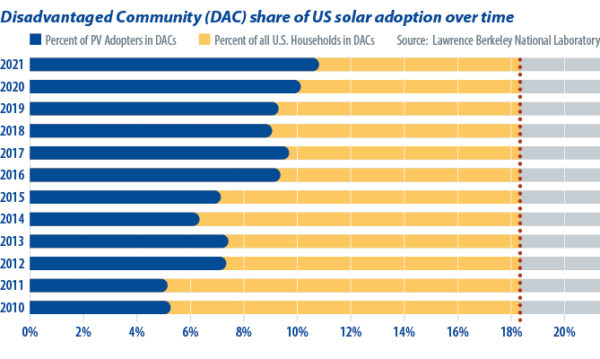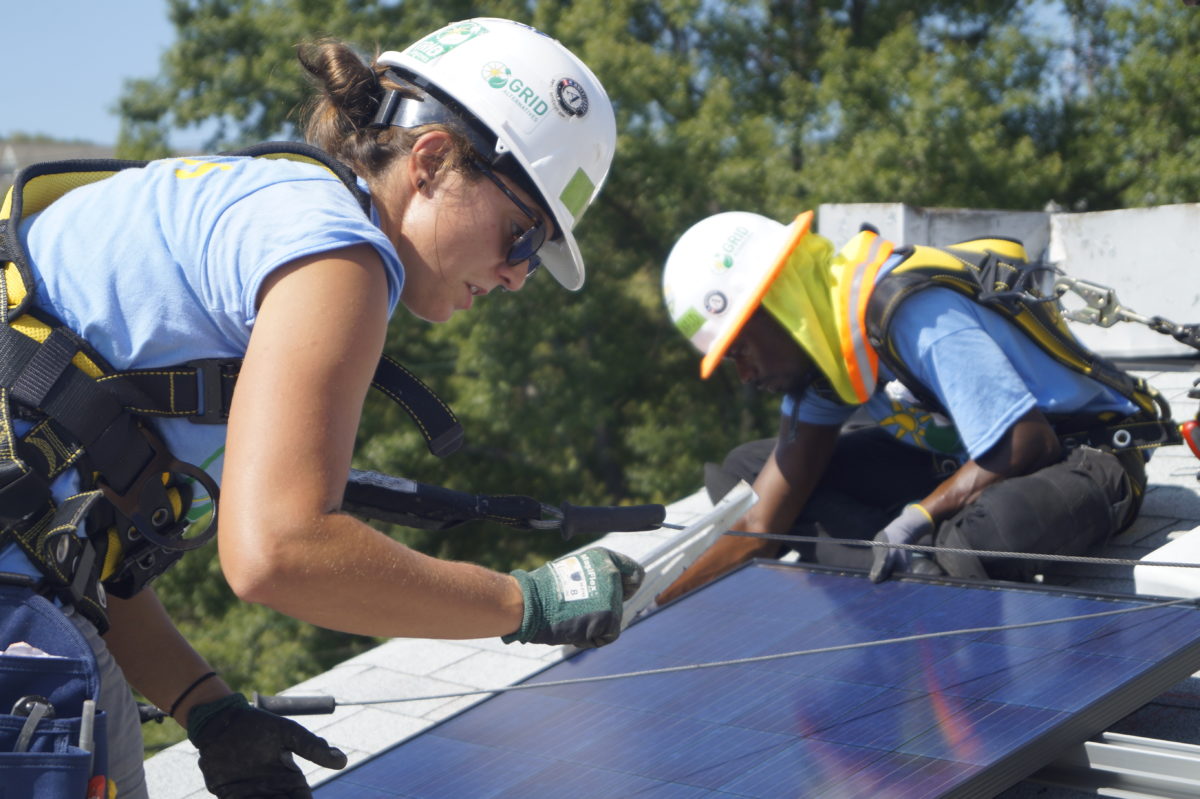Energy justice seeks to correct damage done to people in low-income communities which have long suffered from fossil fuel pollution near their homes, lack of access to renewables-driven affordable electricity, climate change, and more. The concept is broadly referred to as environmental justice. But that term casts a much wider net, to include cross-cutting issues such as healthcare and transportation, whereas energy justice focuses on making affordable energy accessible to all. Renewable energy plays an important role in bringing energy justice to disadvantaged communities as clean energy can bring relief in many forms, including community and residential solar as well as energy storage.
The U.S. Department of Energy has developed a method for designating disadvantaged communities based on 36 criteria related to energy burden, environmental and climate hazards, socio-economic vulnerabilities, and fossil-fuel dependence. While these communities stand to benefit from renewable energy, a recent Berkeley Lab report, “Residential Solar-Adopter Income and Demographic Trends,” indicates that even though the rate of solar adoption among low-income residents is increasing (from 5% in 2010 to 11% in 2021), that segment of energy consumers remains under-represented among solar adopters, relative to its share of the population.
People living in these communities have several barriers to adoption. Many do not own the home they live in and are likely to live in multi-family housing units. Therefore, putting solar on the rooftop is not a viable option. Because such households are on low incomes, they often have low credit scores and cannot take advantage of the no-upfront-cost lease options on the market. Furthermore, their budgets are stretched thin – especially in the current economic climate – and they have little or no expendable income.
Community solar is especially applicable for those who can’t afford to “go solar” on their own, those who don’t own a rooftop, and those whose rooftops are not suitable for solar. Community solar is a solar project or purchasing program in which the energy from a solar project flows to multiple customers within a certain geographic area. The concept is taking off in the United States. For example in August, pv magazine USA reported that the community solar market in the U.S. would add at least 7 GW (DC) of generation capacity in existing markets over the next five years, based on a report by analyst Wood Mackenzie and the Coalition for Community Solar Access (CCSA).
However, the availability of community solar is a challenge. According to Olivia Nedd, senior policy director for access and equity at clean energy nonprofit Vote Solar, “some states are more adept at allowing community solar-enabling legislation, like California and Colorado.” Others, she said, “put up every roadblock barrier that you can imagine to stop community solar legislation or any kind of rooftop advancement.” She noted that in areas that lack policies to support community solar, low-income people face challenges in understanding how to access the technology.
Vote Solar is one of the groups working to make a difference by identifying programs and funding streams and then providing support to partners throughout the process of going solar. The group tries to connect people who want solar energy with community-based organizations, frontline groups, and individuals who can also provide input on how they should be spending their money.
Fortunately, there are incentives in the Inflation Reduction Act (IRA) that promote the development of community solar in the United States. “The support can be so significant, it can transform communities,” Nedd said. “But we need to put a massive asterisk on it because it requires developers to take up projects within low-income communities.”
The IRA offers support in the form of tax incentives, with a 30% tax credit for the solar installation plus three adders that can add up to 70%. Additionally, the IRA includes the interconnection fee in that tax credit. This all should be incentive enough but, as Nedd points out, more effort is needed to engage communities. “Community-based organizations need sufficient time to provide input on how the programs are designed because these programs are what’s going to impact them,” she said.
The CCSA is a national trade group that seeks to expand access to community solar. Jeff Cramer, president and chief executive of the CCSA, said that with about 75% of American households lacking the ability to put solar on their rooftop, community solar serves as the key pathway to accessing the benefits of local distributed solar. The CCSA works at the state and federal level to create sustainable and scalable programs that benefit all customers and the grid. The group is working with a broad set of stakeholders to figure out how to ensure that the benefits laid out in the IRA are going to the customers that need it most. The CCSA aims to bring projects online quickly, sustainably, and scalably over the ten-year life of the IRA tax credit.

Cramer noted that another piece of legislation which applies to low-income residents is the Environmental Protection Agency’s Greenhouse Gas Reduction Fund, which is a $7 billion program of federal funds to support state governments and other eligible entities to create or expand distributed solar programs that provide benefits for low to moderate-income customers.
Grid Alternatives is another group working to bring equitable energy to those who need it most. This non-profit organization is dedicated to helping communities get clean, affordable renewable energy in addition to transportation and jobs. The group has an international focus, with energy justice work ongoing in the United States, Nepal, Nicaragua, and Mexico. Since 2004, Grid Alternatives has served more than 27,000 households, 204 community facilities – such as apartment buildings and nonprofits – and has saved families a combined total of $640 million. Its installations have produced almost 2.63 TWh of electricity, or the equivalent of saving more than a million tons of greenhouse gas emissions. Grid Alternatives not only helps low-income families go solar, it also provides a training program that has helped launch new solar careers for nearly 40,000 people.
State focus
A few states have strong energy justice programs, including Illinois, New York, Colorado, and California. In September 2021, Illinois passed the Climate and Equitable Jobs Act, which focuses on climate change, racism, and economic divestment. As its name implies, it prioritizes job training, hiring, ownership, and entrepreneurship in low-income communities.
New York has a similar policy. In its Climate Leadership and Community Protection Act of 2019, which requires a minimum 40% of all state climate and equity spending to go to frontline Black, brown, and low-income communities. Furthermore, New York’s plan to achieve 10 GW of distributed solar by 2030 calls for 1.6 GW of newly deployed solar to benefit disadvantaged communities.
In Colorado, campaign group the Environmental Justice Coalition and other parties challenged utility Xcel Energy to support more-equitable clean energy. The power company agreed to dedicate $32.8 million toward renewable energy programs and incentives for low-income customers and those in disadvantaged communities. Up to $52.6 million is also set aside for community solar projects, and $6.5 million will go toward approximately 10 MW of energy storage capacity.
In California, the Community Renewable Energy Act (AB 2316) creates a community renewable energy program which includes community solar-plus-storage options. The CCSA’s Cramer said his organization believes that this funding can serve as “a catalyst to create long-term sustainable and scalable low-income solar programs and distributed solar programs.”
Inflation Reduction Act
The IRA legislative package which was passed in August in the U.S. offers several grant programs designed specifically to help launch meaningful initiatives to improve public health, reduce pollution, and revitalize marginalized and underserved communities. Considered the most significant climate legislation in U.S. history, it encourages clean energy adoption across the board and it is possible that it will have its greatest impact on overburdened communities. For example, the IRA includes the Justice40 Initiative, which supports programs that improve clean transit and workforce development while also investing in programs that make clean energy more affordable and accessible and strengthen resilience to climate change.
The IRA also set up a Clean Energy and Sustainability Accelerator, which will seed state and local clean energy financing institutions and support deployment of zero-emission technologies. Half of those investments are prioritized for disadvantaged communities. Furthermore, programs specific to tribal communities offer rebates on the purchase of efficient electric appliances, to bring clean power to homes that have lacked electricity, and more.
“The money’s on the table now,” said Cramer. While there are groups pushing for solar access for all, and states with strong legislation, there are other pockets of interest in surprising places in the United States. For example, Louisiana has no policy for community solar or support for low-income residents going solar but the city of New Orleans has its own utility commission with a community solar program. In Nebraska, forward-looking co-operatives have created community solar projects.
“I think it’s starting with a seed of interest that continues to grow,” said Cramer. As the movement grows, he added, “the benefits of community solar become undeniable and the desire to develop capacity gains momentum.” Ultimately, it’s about making sure that those interests grow and continue to call for access to solar in the name of energy justice for all.
This content is protected by copyright and may not be reused. If you want to cooperate with us and would like to reuse some of our content, please contact: editors@pv-magazine.com.









By submitting this form you agree to pv magazine using your data for the purposes of publishing your comment.
Your personal data will only be disclosed or otherwise transmitted to third parties for the purposes of spam filtering or if this is necessary for technical maintenance of the website. Any other transfer to third parties will not take place unless this is justified on the basis of applicable data protection regulations or if pv magazine is legally obliged to do so.
You may revoke this consent at any time with effect for the future, in which case your personal data will be deleted immediately. Otherwise, your data will be deleted if pv magazine has processed your request or the purpose of data storage is fulfilled.
Further information on data privacy can be found in our Data Protection Policy.